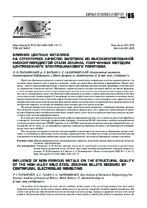| dc.contributor.author | Папковский, П. И. | |
| dc.contributor.author | Валько, А. Л. | |
| dc.contributor.author | Сандомирский, С. Г. | |
| dc.coverage.spatial | Минск | ru |
| dc.date.accessioned | 2020-04-03T10:50:31Z | |
| dc.date.available | 2020-04-03T10:50:31Z | |
| dc.date.issued | 2020 | |
| dc.identifier.citation | Папковский, П. И. Влияние цветных металлов на структурное качество заготовок из высоколегированной низкоуглеродистой стали 20Х2Н4А, полученных методом центробежного электрошлакового переплава = Influence of non-ferrous metals on the structural quality of the high-alloy mild steel 20X2H4А billets received by centrifugal electroslag remelting / П. И. Папковский, А. Л. Валько, С. Г. Сандомирский // Литье и металлургия. – 2020. – № 1. – С. 65-73. | ru |
| dc.identifier.uri | https://rep.bntu.by/handle/data/70357 | |
| dc.description.abstract | Проблема образования трещин и условия их зарождения в литой металлопродукции изучена в мировой практике, но механизм этого процесса еще не выяснен настолько, чтобы его можно было применить в производстве. Горячие тре- щины – один из самых распространенных и наиболее убыточных пороков стальных отливок, приводящих к значительно- му удорожанию стоимости изделий. Образование горячих трещин в стальных отливках зависит от многих факторов, к числу которых относятся химический состав стали, наличие в нем неметаллических включений и газов, условия рас- кисления и затвердевания стали и др. Поэтому особое внимание в реальных условиях производства необходимо уделять металлургической стороне вопроса. В литературе по металлургии нет количественного показателя чистоты стали, которая подразделяется на химическую, определяемую химическим анализом, и металлографическую, определяемую по содержанию неметаллических включений. Если влияние общей чистоты стали на характеристики разрушения изучено достаточно подробно, то данные об индивидуальном влиянии примесей весьма неполные. По многим показателям чистая сталь имеет явные преимущества по сравнению с содержащей вредные примеси. Это относится ко всем механическим свойствам, связанным с разрушением, или к процессам, происходящим на грани- це зерен. Кардинальным способом получения более чистой стали, в том числе и по примесям цветных металлов, являет- ся применение чистой первородной шихты. В статье рассмотрены вопросы актуальной проблемы образования трещин после химико-термической обработки в материале солнечных шестерен второго ряда карьерных самосвалов БЕЛАЗ, полученных методом центробежного электрошлакового переплава (ЦЭШП) проката стали 20Х2Н4А, возможного влияния малых концентраций цветных ме- таллов (Pb, Zn, Sn, Sb, Bi, As, Se) на развитие наружных и внутренних трещин в отливках и на структурную неоднород- ность стали после ЦЭШП. Рассмотренные результаты позволили сделать выводы о влиянии цветных металлов на образование трещин в от- ливках и установить их предельные количественные характеристики. На основе полученных результатов предложены мероприятия по минимизации воздействия малых количеств цветных металлов на образование трещин в отливках. | ru |
| dc.language.iso | ru | ru |
| dc.publisher | БНТУ | ru |
| dc.title | Влияние цветных металлов на структурное качество заготовок из высоколегированной низкоуглеродистой стали 20Х2Н4А, полученных методом центробежного электрошлакового переплава | ru |
| dc.title.alternative | Influence of non-ferrous metals on the structural quality of the high-alloy mild steel 20X2H4А billets received by centrifugal electroslag remelting | ru |
| dc.type | Article | ru |
| dc.identifier.doi | 10.21122/1683-6065-2020-1-65-73 | |
| local.description.annotation | The problem of the formation of cracks and the conditions of their origin in the cast of metal products have been widely studied in world practice, but the real mechanism of this process is not yet clear enough that it could be applied in production. Hot cracks – one of the most common and the most detrimental defects of steel castings, leading to a significant increase in the cost of products. The formation of hot cracks in steel castings depends on many factors, including the chemical composition of steel, the presence of non-metallic inclusions and gases, conditions of deoxidation and solidification of steel, etc. Therefore, special attention in the real conditions of production should be given to the metallurgical side of the issue. There is no quantitative measure of steel purity in the books of steel, which is divided into chemical, defined by the chemical analysis, and metallographic, defined by the content of non-metallic inclusions. The effect of the general purity of steel on the characteristics of destruction is studied sufficiently, but the data on the individual impact of impurities is very incomplete. In many respects, pure steel has a clear advantage over steel with harmful impurities. This applies to all mechanical properties associated with destruction or processes occurring on the edge of grains. The cardinal way of obtaining cleaner steel, including the reduction of impurities of non-ferrous metals, is the use of pure original charge mixture. The article discusses the topical problem of cracking formation after chemical-thermal treatment in the material of sun gears of the second row of quarry dump trucks BELAZ, obtained by the method of CESR rolled steel 20X2H4А, the possible impact of small concentrations of non-ferrous metals (Pb, Zn, Sn, Bi, As, Se) on the development of external and internal cracks in castings and on structural heterogeneity of steel after CESR. The obtained results allowed to draw conclusions about the impact of non-ferrous metals on the formation of cracks in castings and to establish their limited quantitative characteristics. Based on the results, measures have been proposed to minimize the impact of small amounts of non-ferrous metals on the formation of cracks in castings. | ru |

